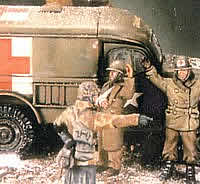| U.S.
POW's Standing, Battle of the Bulge |
 |
|
When the December 1944 German offensive smashed through the thin American lines in the Ardennes, they caught thousands of soldiers unawares. Most of them had been sent there for R&R and refitting, particularly the 28th Infantry Division, which had been severely mauled in the savage fighting of the Hürtgen Forest a few weeks earlier. Many of the soldiers on the line were green reinforcements, whose first taste of combat was this overwhelming juggernaut. Some broke and ran, but enough stayed and fought with little ammunition or supplies, trying to hold on until help could arrive. They managed to delay the German advance, buying time for the 101st Airborne Division to secure its hold on the pivotal town of Bastogne. In the process, however, thousands of GIs were taken prisoner in the worst rout the US experienced in WWII. These
two figures reflect the experiences of many American soldiers in
the initial days of combat. Surrendering, they stand and await their
fate. One wears the long wool melton overcoat with brass buttons.
It is worn open over one shoulder as his right arm is wounded and
held in a sling. The open coat reveals a cable knit sweater that
can be painted an Army issue field drab. He wears no leggings, his
trouser legs falling over his combat boots. Neither soldier has any web gear; though the package photo shows the figure in the mackinaw as a medic with the Red Cross insignia on his helmets, he could be any soldier during the early fighting (there are no insignia decals with the figures). Both have scarves under their helmets and pulled around their faces. The molding is crisp, with a bit of cleanup necessary around the legs. The torso and leg sections are one piece. A striking feature of this set is that the wounded figure is noticeably shorter than the other, who appears to stand around 6’. The wounded GI is around 5’6” -- which was about the average size of combatants during the war. The reason this difference in height works, as opposed to the problem of mixing several different brands of figures, is that their helmets are the same size. Since the M1 steel pot helmet was “one-size-fits-all,” that and standard-sized weapons are the most crucial factors in maintaining an accurate scaling across brands. Going by the helmets and the taller figure, these GIs would be best placed in the company from soldiers from Verlinden, DML, Warriors and Jaguar. If you can find this and the companion set #9603 “U.S. POW’s Walking” you’ve got a good start on a diorama of some of the Allies’ darkest days. -tss- |
 |
 |
 |
 |
 |
 |
 |
 |
 |
 |
 |
 |
|
